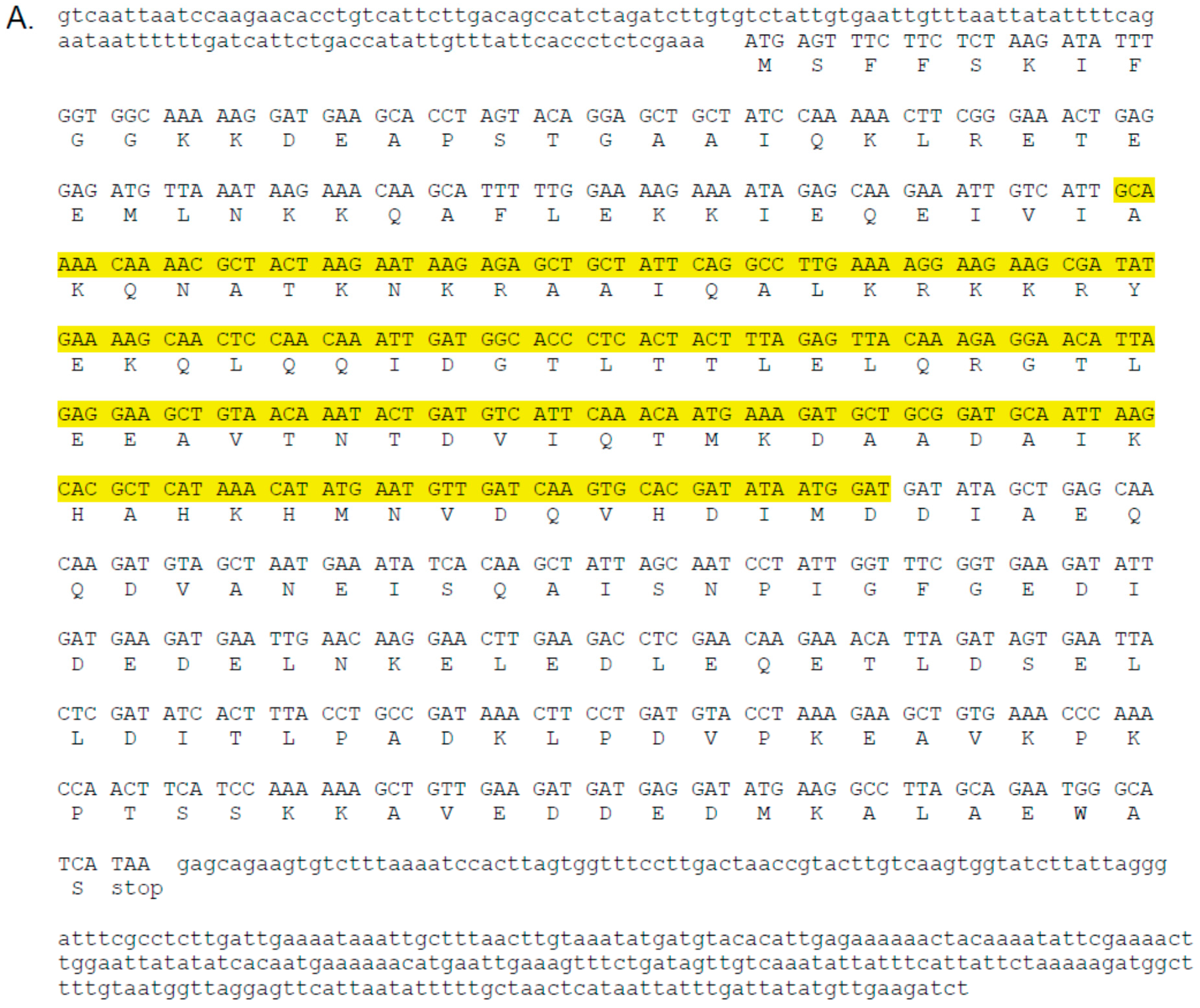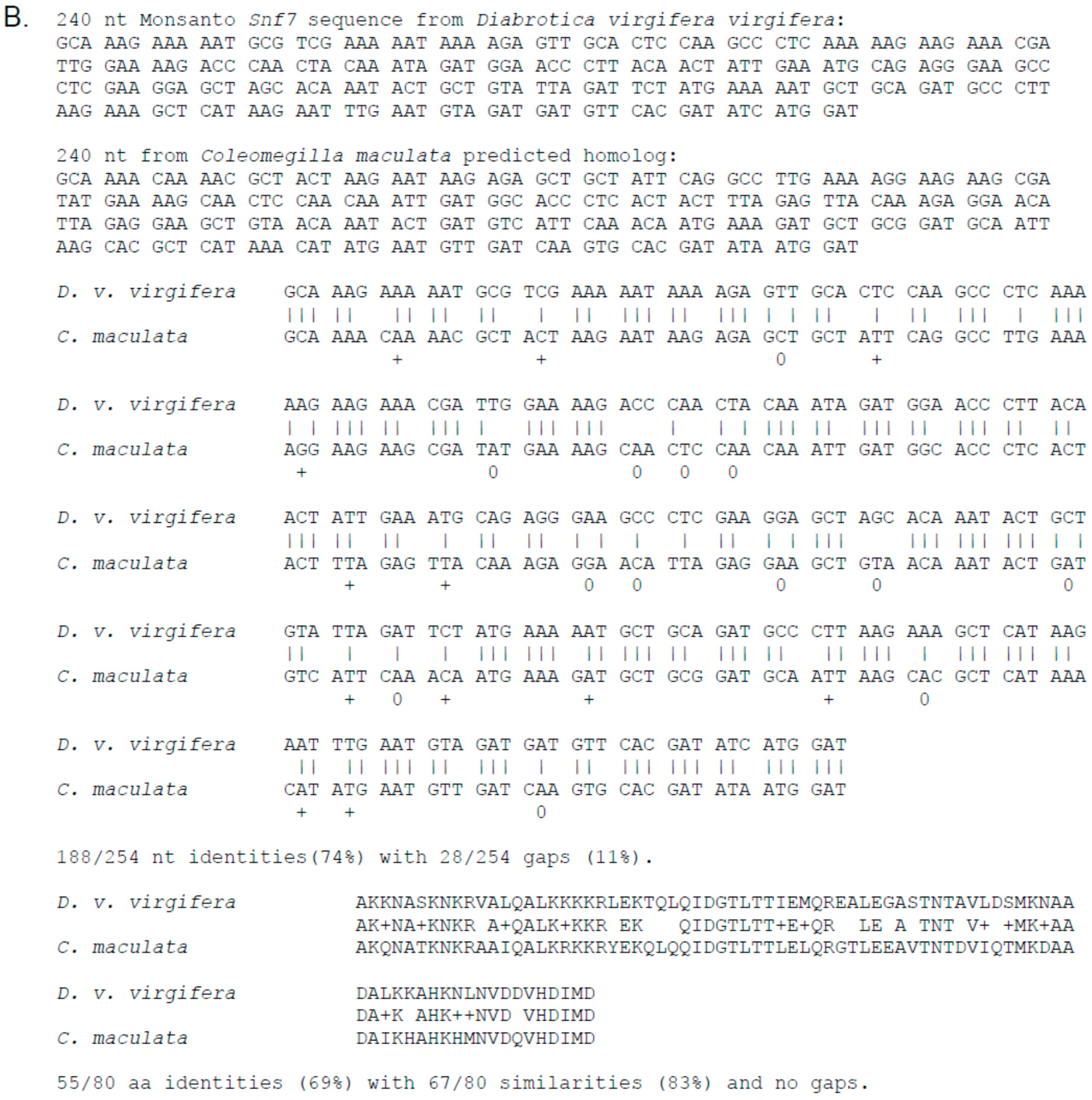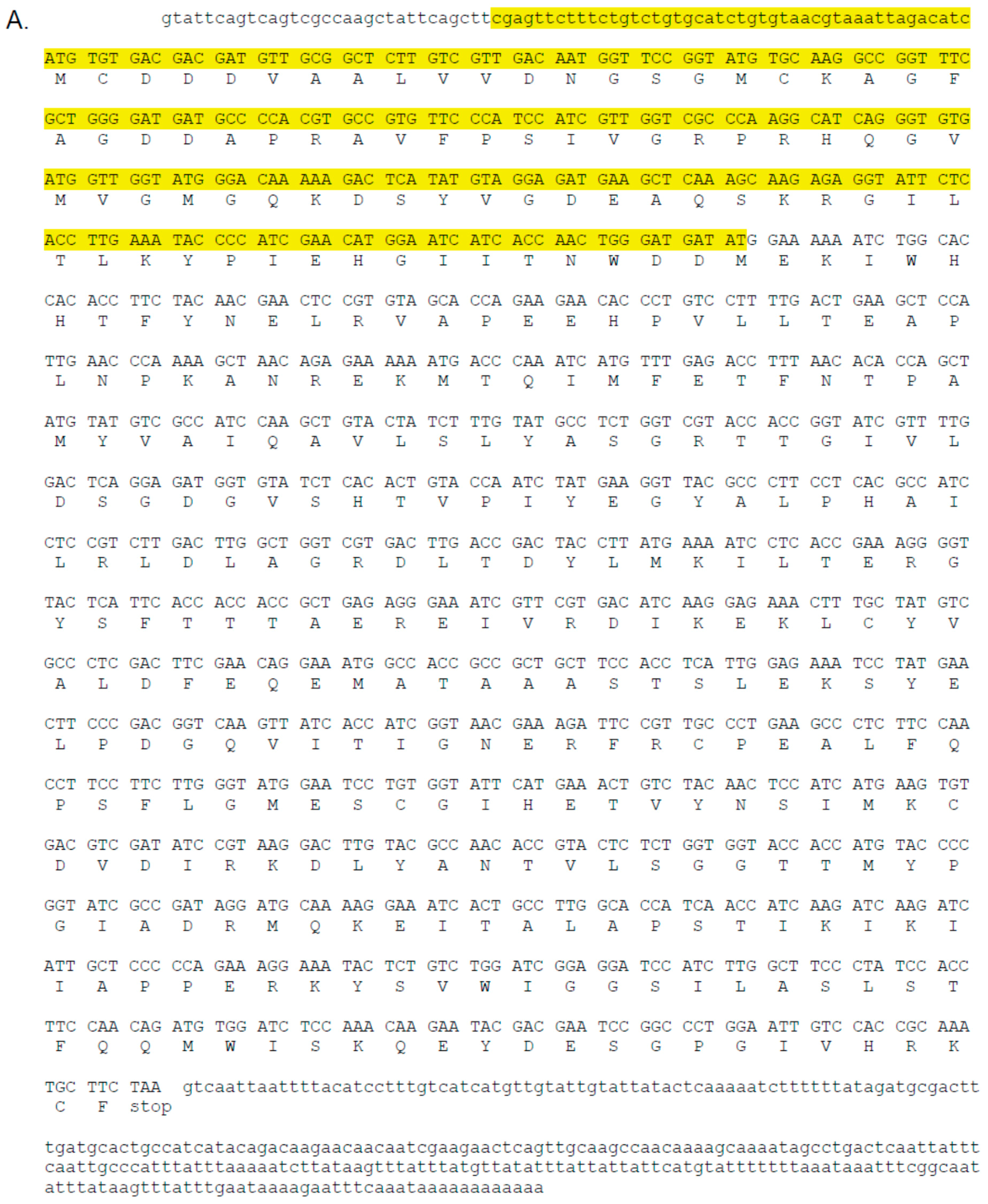Comparison of RNAi Sequences in Insect-Resistant Plants to Expressed Sequences of a Beneficial Lady Beetle: A Closer Look at Off-Target Considerations
Abstract
:1. Introduction
2. Materials and Methods
Identification of C. maculata Sequences and Comparisons
3. Results
4. Discussion
5. Conclusions
Acknowledgments
Conflicts of Interest
References
- Poelchau, M.F.; Coates, B.S.; Childers, C.P.; Peréz de León, A.A.; Evans, J.D.; Hackett, K.; Shoemaker, D. Agricultural applications of insect ecological genomics. Curr. Opin. Insect Sci. 2016, 13, 61–69. [Google Scholar] [CrossRef] [PubMed]
- Baum, J.A.; Bogaert, T.; Clinton, W.; Heck, G.R.; Feldmann, P.; Ilagan, O.; Johnson, S.; Plaetinck, G.; Munyikwa, T.; Pleau, M.; et al. Control of coleopteran insect pests through RNA interference. Nat. Biotechnol. 2007, 25, 1322–1326. [Google Scholar] [CrossRef] [PubMed]
- Bachman, P.M.; Bolognesi, R.; Moar, W.J.; Mueller, G.M.; Paradise, M.S.; Ramaseshadri, P.; Tan, J.; Uffman, J.P.; Warren, J.; Wiggins, B.E.; et al. Characterization of the spectrum of insecticidal activity of a double-stranded RNA with targeted activity against western corn rootworm (Diabrotica virgifera virgifera LeConte). Transgenic Res. 2013, 22, 1207–1222. [Google Scholar] [CrossRef] [PubMed]
- Bolognesi, R.; Ramaseshadri, P.; Anderson, J.; Bachman, P.; Clinton, W.; Flannagan, R.; Ilagan, O.; Lawrence, C.; Levine, S.; Moar, W.; et al. Characterizing the mechanism of action of double-stranded RNA activity against western corn rootworm (Diabrotica virgifera virgifera LeConte). PLoS ONE 2012, 7, e47534. [Google Scholar] [CrossRef] [PubMed]
- Koci, J.; Ramaseshadri, P.; Bolognesi, R.; Segers, G.; Flannagan, R.; Park, Y. Ultrastructural changes caused by Snf7 RNAi in larval enterocytes of western corn rootworm (Diabrotica virgifera virgifera LeConte). PLoS ONE 2014, 9, e83985. [Google Scholar] [CrossRef] [PubMed]
- Ramaseshadri, P.; Segers, G.; Flannagan, R.; Wiggins, E.; Clinton, W.; Ilagan, O.; McNulty, B.; Clark, T.; Bolognesi, R. Physiological and cellular responses caused by RNAi- mediated suppression of Snf7 orthologue in western corn rootworm (Diabrotica virgifera virgifera) larvae. PLoS ONE 2013, 8, e54270. [Google Scholar] [CrossRef] [PubMed]
- Zhang, J.; Khan, S.A.; Hasse, C.; Ruf, S.; Heckel, D.G.; Bock, R. Full crop protection from an insect pest by expression of long double-stranded RNAs in plastids. Science 2015, 347, 991–994. [Google Scholar] [CrossRef] [PubMed]
- Zhu, F.; Xu, J.J.; Palli, R.; Ferguson, J.; Palli, S.R. Ingested RNA interference for managing the populations of the Colorado potato beetle, Leptinotarsa decemlineata. Pest Manag. Sci. 2011, 67, 175–182. [Google Scholar] [CrossRef] [PubMed]
- Mallampalli, N.; Gould, F.; Barbosa, P. Predation of Colorado potato beetle eggs by a polyphagous ladybeetle in the presence of alternate prey: Potential impact on resistance evolution. Entomol. Exp. Appl. 2005, 114, 47–54. [Google Scholar] [CrossRef]
- Lundgren, J.G.; Wiedenmann, R.N. Nutritional suitability of corn pollen for the predator Coleomegilla maculata (Coleoptera: Coccinellidae). J. Insect Physiol. 2004, 50, 567–575. [Google Scholar] [CrossRef] [PubMed]
- Allen, M.L. Characterization of adult transcriptomes from the omnivorous lady beetle Coleomegilla maculata fed pollen or insect egg diet. J. Genom. 2015, 3, 20–28. [Google Scholar] [CrossRef] [PubMed]
- Ivashuta, S.; Zhang, Y.; Wiggins, B.E.; Ramaseshadri, P.; Segers, G.C.; Johnson, S.; Meyer, S.E.; Kerstetter, R.A.; McNulty, B.C.; Bolognesi, R.; et al. Environmental RNAi in herbivorous insects. RNA 2015, 21, 840–850. [Google Scholar] [CrossRef] [PubMed]
- Ulrich, J.; Dao, V.A.; Majumdar, U.; Schmitt-Engel, C.; Schwirz, J.; Schultheis, D.; Strohlein, N.; Troelenberg, N.; Grossmann, D.; Richter, T.; et al. Large scale RNAi screen in Tribolium reveals novel target genes for pest control and the proteasome as prime target. BMC Genom. 2015, 16, 1–9. [Google Scholar] [CrossRef] [PubMed]
- Pruitt, K.D.; Tatusova, T.; Brown, G.R.; Maglott, D.R. NCBI reference sequences (RefSeq): Current status, new features and genome annotation policy. Nucleic Acids Res. 2012, 40, D130–D135. [Google Scholar] [CrossRef] [PubMed]
- Boratyn, G.M.; Camacho, C.; Cooper, P.S.; Coulouris, G.; Fong, A.; Ma, N.; Madden, T.L.; Matten, W.T.; McGinnis, S.D.; Merezhuk, Y.; et al. BLAST: A more efficient report with usability improvements. Nucleic Acids Res. 2013, 41, W29–W33. [Google Scholar] [CrossRef] [PubMed]
- Stothard, P. The sequence manipulation suite: JavaScript programs for analyzing and formatting protein and DNA sequences. BioTechniques 2000, 28, 1102–1104. [Google Scholar] [PubMed]
- Artimo, P.; Jonnalagedda, M.; Arnold, K.; Baratin, D.; Csardi, G.; de Castro, E.; Duvaud, S.; Flegel, V.; Fortier, A.; Gasteiger, E.; et al. Expasy: SIB bioinformatics resource portal. Nucleic Acids Res. 2012, 40, W597–W603. [Google Scholar] [CrossRef] [PubMed]
- Schmitt-Engel, C.; Schultheis, D.; Schwirz, J.; Strohlein, N.; Troelenberg, N.; Majumdar, U.; Dao, V.A.; Grossmann, D.; Richter, T.; Tech, M.; et al. The iBeetle large-scale RNAi screen reveals gene functions for insect development and physiology. Nat. Commun. 2015. [Google Scholar] [CrossRef] [PubMed]
- Whangbo, J.S.; Hunter, C.P. Environmental RNA interference. Trends Genet. 2008, 24, 297–305. [Google Scholar] [CrossRef] [PubMed]
- Huang, G.Z.; Allen, R.; Davis, E.L.; Baum, T.J.; Hussey, R.S. Engineering broad root-knot resistance in transgenic plants by RNAi silencing of a conserved and essential root-knot nematode parasitism gene. Proc. Natl. Acad. Sci. USA 2006, 103, 14302–14306. [Google Scholar] [CrossRef] [PubMed]
- Yadav, B.C.; Veluthambi, K.; Subramaniam, K. Host-generated double stranded RNA induces RNAi in plant-parasitic nematodes and protects the host from infection. Mol. Biochem. Parasitol. 2006, 148, 219–222. [Google Scholar] [CrossRef] [PubMed]
- Mao, Y.B.; Cai, W.J.; Wang, J.W.; Hong, G.J.; Tao, X.Y.; Wang, L.J.; Huang, Y.P.; Chen, X.Y. Silencing a cotton bollworm p450 monooxygenase gene by plant-mediated RNAi impairs larval tolerance of gossypol. Nat. Biotechnol. 2007, 25, 1307–1313. [Google Scholar] [CrossRef] [PubMed]
- Ahmad, A.; Negri, I.; Oliveira, W.; Brown, C.; Asiimwe, P.; Sammons, B.; Horak, M.; Jiang, C.; Carson, D. Transportable data from non-target arthropod field studies for the environmental risk assessment of genetically modified maize expressing an insecticidal double-stranded RNA. Transgenic Res. 2016, 25, 1–17. [Google Scholar] [CrossRef] [PubMed]
- Lundgren, J.G.; Huber, A.; Wiedenmann, R.N. Quantification of consumption of corn pollen by the predator Coleomegilla maculata (Coleoptera: Coccinellidae) during anthesis in an Illinois cornfield. Agric. For. Entomol. 2005, 7, 53–60. [Google Scholar] [CrossRef]
- Romeis, J.; Meissle, M.; Alvarez-Alfageme, F.; Bigler, F.; Bohan, D.A.; Devos, Y.; Malone, L.A.; Pons, X.; Rauschen, S. Potential use of an arthropod database to support the non-target risk assessment and monitoring of transgenic plants. Transgenic Res. 2014, 23, 995–1013. [Google Scholar] [CrossRef] [PubMed]
- Good, R.T.; Varghese, T.; Golz, J.F.; Russell, D.A.; Papanicolaou, A.; Edwards, O.; Robin, C. Offtarget Finder: A web tool for species-specific RNAi design. Bioinformatics 2016, 32, 1232–1234. [Google Scholar] [CrossRef] [PubMed]




| Symbol/Name | Refseq ID | Sequence Identification from C. maculata Transcriptomes | T. castaneum vs. C. maculata | ||||
|---|---|---|---|---|---|---|---|
| Pollen-Fed | Insect Egg-Fed | Similarity (C. mac) | aa Identities | nt Similarity | 17+ nt Matches | ||
| L10/cact | NM_001163711 | not found | not found | n/a | n/a | n/a | n/a |
| L11/srp54k | XM_962796 | comp3017 | comp3093 | 1558/1558 | 474/508 | 1104/1415 (78%) | 2 |
| L44/rop | NM_001170684 | comp12493 | comp11584 | 2442/2449 | 528/590 | 1321/1781 (74%) | 4 |
| L47/alpha snap | XM_968056 | comp8167 | comp5787 | 2338/2338 | 212/241 | 651/879 (74%) | 1 |
| L50/shi | XM_008200600 | not found | not found | n/a | n/a | n/a | n/a |
| L55/pp1alpha-96a | XM_001813922 | comp10238 | comp10443 | 1751/1752 | 318/327 | 781/986 (79%) | 0 |
| L67/inr-a | XM_008194324 | not found | not found | n/a | n/a | n/a | n/a |
| L76/hsc70-3 | XM_008202764 | comp14394 | comp13114 | 2433/2488 | 598/645 | 1528/1924 (79%) | 8/7 |
| L80/rpn7 | XM_968550 | comp12477 | comp14743 | 1296/1301 | 322/389 | 849/1173 (72%) | 1 |
| L82/gw | XM_015982857 | comp8599 | comp10202 | 4423/4424 | 967/1388 | 1781/2609 (68%) | 11 |
| L84/rpt3 | XM_962883 | comp3229 | comp12416 | 1406/1434 | 393/409 | 907/1211 (75%) | 1 |
© 2017 by the author. Licensee MDPI, Basel, Switzerland. This article is an open access article distributed under the terms and conditions of the Creative Commons Attribution (CC BY) license ( http://creativecommons.org/licenses/by/4.0/).
Share and Cite
Allen, M.L. Comparison of RNAi Sequences in Insect-Resistant Plants to Expressed Sequences of a Beneficial Lady Beetle: A Closer Look at Off-Target Considerations. Insects 2017, 8, 27. https://doi.org/10.3390/insects8010027
Allen ML. Comparison of RNAi Sequences in Insect-Resistant Plants to Expressed Sequences of a Beneficial Lady Beetle: A Closer Look at Off-Target Considerations. Insects. 2017; 8(1):27. https://doi.org/10.3390/insects8010027
Chicago/Turabian StyleAllen, Margaret L. 2017. "Comparison of RNAi Sequences in Insect-Resistant Plants to Expressed Sequences of a Beneficial Lady Beetle: A Closer Look at Off-Target Considerations" Insects 8, no. 1: 27. https://doi.org/10.3390/insects8010027






